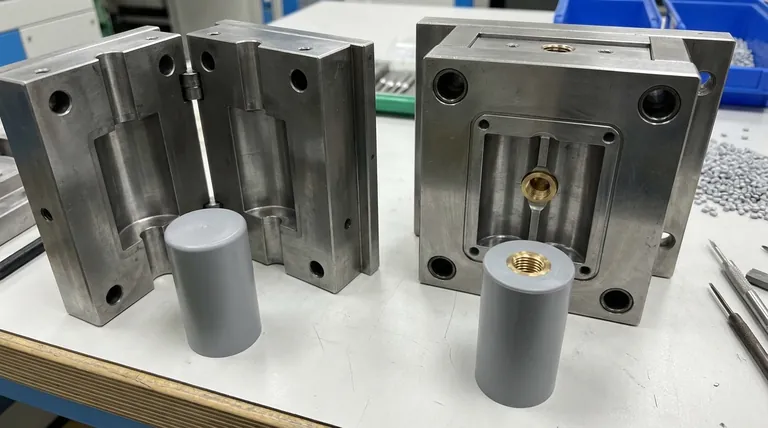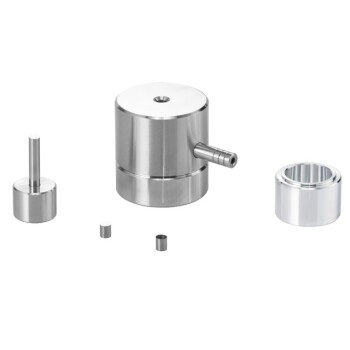The primary difference is that insert molding is a specific type of injection molding. Standard injection molding creates a fully plastic part, while insert molding begins by placing a non-plastic component—the "insert"—into the mold before injecting molten plastic around it to create a single, integrated piece.
The core distinction is not about two different processes, but about a specialized application. Insert molding uses the standard injection molding process to encapsulate a pre-existing component (like a metal thread or electrical pin) within a plastic part, bonding them together permanently.

The Fundamental Process: Standard Injection Molding
Standard injection molding is the foundation for creating the vast majority of plastic products. The process is straightforward and highly repeatable.
The Three Core Steps
- Material Melting: Plastic pellets are fed into a heated barrel, melted, and mixed into a homogenous molten liquid.
- Injection: This molten plastic is then injected under high pressure into a precisely machined, two-part metal mold.
- Cooling and Ejection: The plastic cools and solidifies within the mold, taking its shape. The mold then opens, and the finished plastic part is ejected.
The Specialized Process: Insert Molding
Insert molding modifies the standard process by adding a crucial preliminary step. It is the go-to method for seamlessly combining plastic with other materials, most commonly metal.
The Core Difference: The Pre-Placed Component
Before the mold is closed and injected with plastic, an "insert" is placed into the mold cavity. This insert is a pre-manufactured component, such as a threaded brass boss, a steel screw, or an electrical contact.
The Encapsulation Step
Once the insert is securely held in place, the mold closes, and molten plastic is injected. The plastic flows around the insert, conforming to its shape and locking it permanently into position as the plastic cools and hardens.
Manual vs. Automated Placement
The inserts can be placed into the mold manually by an operator for smaller production runs or by a robotic arm for high-volume, automated manufacturing. This placement step is the key variable affecting cycle time.
Why Choose Insert Molding? Key Advantages
Opting for insert molding is a strategic design choice that offers significant functional and economic benefits by eliminating the need for post-molding assembly.
Enhanced Strength and Durability
Placing a metal insert at a key stress point drastically reinforces a plastic part. It provides a robust connection point for screws or bolts that a plastic-only thread could not match.
Integrated Functionality
Insert molding is the most effective way to add features that plastic cannot provide on its own. This includes creating parts with integrated electrical pins, conductive paths, threaded fasteners, or bushings for rotating shafts.
Reduced Assembly Costs
By creating a finished, multi-material component directly out of the mold, you eliminate downstream labor and equipment costs associated with manually pressing, gluing, or screwing inserts into a part after the fact.
Understanding the Trade-offs and Considerations
While powerful, insert molding introduces complexities that require careful planning. Understanding these trade-offs is crucial for successful implementation.
Higher Upfront Tooling Costs
An insert mold is more complex than a standard injection mold. It requires additional features to hold the insert precisely in place against the high pressure of injection, which can increase the initial cost of the tool.
Potentially Slower Cycle Times
The need to place an insert into the mold before each cycle adds time. While automation can minimize this, it rarely matches the speed of a fully automated, insert-free molding process.
Precision is Non-Negotiable
The insert must be manufactured to tight tolerances to ensure it fits perfectly within the mold. Any deviation can lead to plastic flashing (leaking) around the insert or damage to the expensive mold itself.
Material Compatibility
Designers must account for the different rates of thermal expansion between the insert material and the surrounding plastic. A significant mismatch can cause stress, cracking, or a weak bond as the part cools.
Making the Right Choice for Your Product
Your specific design goal will determine whether the benefits of insert molding justify its added complexity.
- If your primary focus is cost-effective, high-volume production of a simple, all-plastic part: Standard injection molding is your most efficient and economical choice.
- If your primary focus is adding robust metal threads or electrical contacts to a plastic housing: Insert molding is the ideal solution for a secure, permanent bond.
- If your primary focus is reinforcing a load-bearing plastic component without making it all metal: Insert molding allows you to strategically place metal for strength while keeping the part lightweight.
- If your primary focus is reducing post-production assembly steps and simplifying your supply chain: Insert molding consolidates manufacturing into a single, highly repeatable process.
Ultimately, choosing insert molding is a decision to integrate functionality directly into the manufacturing process, creating more robust and reliable parts from the very first step.
Summary Table:
| Feature | Standard Injection Molding | Insert Molding |
|---|---|---|
| Primary Goal | Create a fully plastic part | Encapsulate a non-plastic insert within a plastic part |
| Key Process Step | Inject plastic into an empty mold | Place an insert (e.g., metal thread) into the mold before injection |
| Best For | Cost-effective, high-volume plastic parts | Parts requiring integrated metal components, enhanced strength, or reduced assembly |
| Complexity & Cost | Lower tooling complexity and cost | Higher upfront tooling cost and complexity |
| Part Outcome | Single-material plastic component | Permanent, multi-material integrated component |
Ready to enhance your product design with the right molding process?
At KINTEK, we specialize in precision lab equipment and consumables, providing the expertise and solutions for advanced manufacturing techniques like injection and insert molding. Whether you need to create robust multi-material components or high-volume plastic parts, our team can help you optimize your design for strength, functionality, and cost-efficiency.
Contact our experts today to discuss your project and discover how KINTEK can support your laboratory and manufacturing needs.
Visual Guide

Related Products
- Isostatic Molding Pressing Molds for Lab
- Cylindrical Press Mold for Lab Applications
- Cylindrical Press Mold with Scale for Lab
- Cylindrical Lab Electric Heating Press Mold for Laboratory Applications
- Assemble Square Lab Press Mold for Laboratory Applications
People Also Ask
- What are three-plate molds? Precision Injection Molding for Complex Parts
- What are the structures of molds? Discover the Microscopic Filaments That Build a Colony
- What are the two structures of molds? Understanding Hyphae and Mycelium
- What is a pressing die? The Precision Tool for Shaping Powder into Solid Pellets
- What are the applications of moulding process? Powering Mass Production from Cars to Medical Devices


















